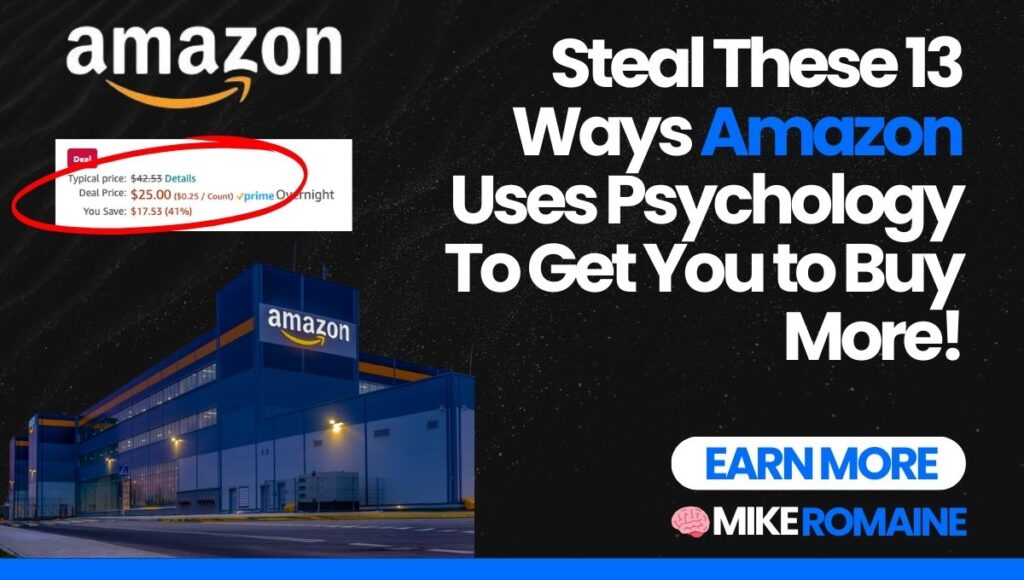Every time you click a product, add to your cart, buy something or make a specific decision, Amazon nudges you in some way leveraging consumer behavior and psychology.
There are limitless ways Amazon continues to use psychology, neuroscience and consumer behavior in their marketing and conversion strategy/testing, but we're going to be covering 13 nudges that are used on you every single day.
I will also be doing my best to link to resources for you to come up with your own ways to implement these nudges into your marketing strategy.
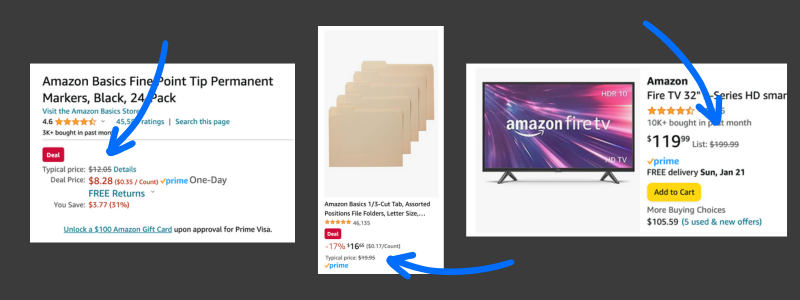
 Price Anchoring
Price Anchoring
Let's start off with one of the most obvious you see all over Amazon's site: price anchoring.
Price anchoring is a cognitive bias where people rely heavily on the first piece of information, the "anchor", they come across when making decisions, especially in the context of pricing.
Amazon uses a lot of different nudges with their pricing that we'll talk about, but I personally think the price anchoring they use is the most prominent as you click through.
Price Anchoring can actually be done in quite a few ways (you likely also see it used a lot with pricing tables), but in this case Amazon has it ALL over their site with their deals.
Here are three examples, all in different places:
- We see a deal on the actual product page and you're shown the "Typical price" above the Deal Price, anchoring us on the initial cost.
- Again we're shown a deal, but this time it's on the Daily Deals page, before we even click into the product page.
- Finally, to show it's not just daily deals, the image of the TV comes from a quick search for TVs and is found scrolling down a normal page before clicking into the product page.
Each time Amazon makes sure to show us the "Typical price" point.
If you want to learn more about how you can incorporate price anchoring in your strategy you can check out my LinkedIn carousel on how how top creators are using price anchoring to drive more sales.
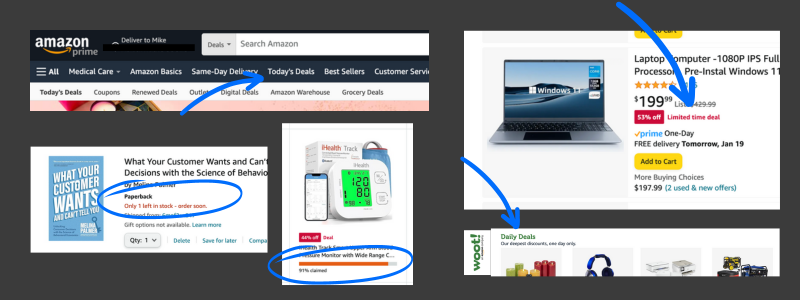
 Scarcity and Urgency
Scarcity and Urgency
Next up we have another two psychological principles we see used often on Amazon.
Both are closely related, but unique enough where I will be pointing them out individually as well.
Scarcity is one of of Richard Cialdini's 7 Principles of Influence (written in his book Influence), and we see it used often by Amazon.
Scarcity is a strategy that leverages the psychological principle of limited availability to influence consumer behavior and drive demand for a product or service.
In the examples above I show how Amazon:
- Shows how much of a limited time offer is claimed before the offer goes away.
- Tells us when stock is limited, and reminds us of the need to order soon if we don't want to miss out.
Similar to this, Amazon also employs urgency in many ways.
Urgency refers creating a need for immediate action for our customer. It involves creating a sense of time-sensitivity with an offer, promotion, or opportunity, nudging people to make a quicker decisions.
In the examples above I show how Amazon:
- Daily Deals
- Limited Time Offers
- Woot! Daily Deals
Daily deals work so well, Amazon acquired Woot! in 2010 which offers special daily deals and limited time offers across categories like home items, electronics, apparel, and more.
Both of these nudges play on our FOMO (Fear Of Missing Out) on offers, and both can be used in a multitude of ways to drive more sales.
You can see how Justin Welsh Uses 6 Psychological Nudges to Drive 1M+ in Course Sales a Year (including Scarcity)!
Bonus Note: We can't forget Prime Day! Amazon uses Prime Day as a way to use Scarcity, Urgency, Exclusivity and more!
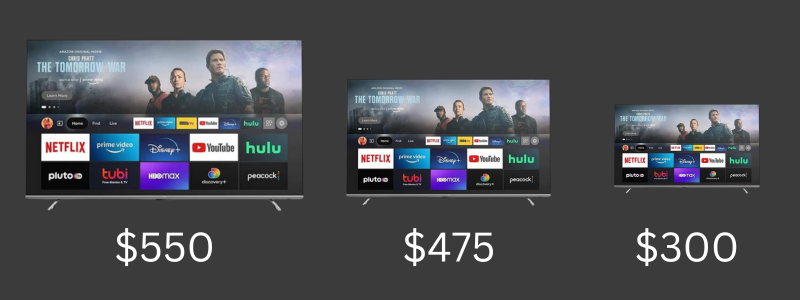
 Decoy Effect and Price Priming/Perception
Decoy Effect and Price Priming/Perception
Next up we have The Decoy Effect and Price Priming.
The Decoy Effect is a cognitive bias observed in decision-making when the introduction of a third option, known as the "decoy," influences individuals to change their preference between two existing options.
My favorite example of this is popcorn at a movie theater when you have a small popcorn for $3, a medium for $6 and a large for $7 - making the upgrade to large seem like a no-brainer if you're going to go with a bigger option!
You can see me use this example in a LinkedIn carousel going through 5 different psychological pricing strategies you can use in your pricing strategy (including The Decoy Effect).
Amazon uses this with it's pricing to get us to choose upgraded models of objects like TVs, but they also use Price Priming as well.
A study by Boomerang found that Amazon offered a $350 TV for $250 on Black Friday, a price that undercut most of its competitors. As it discounted the TV, however, Amazon spiked the price for an HDMI cable that went with it. Similarly, Boomerang found a case where Amazon sold a best-selling computer for 20% less than Walmart, but then sold a less-popular version for 29% higher.
Both of these examples can be used to change the perception of the offer they are running, or "priming" the price of that offer.
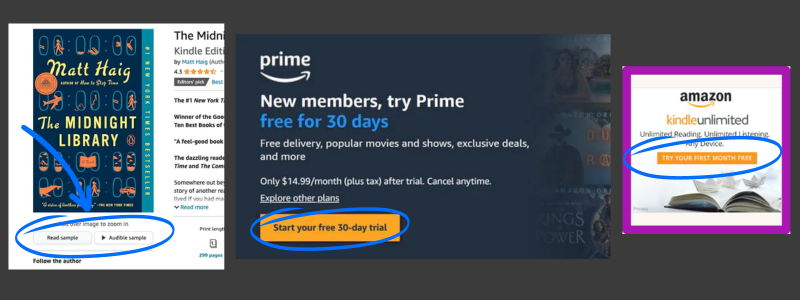
 Foot In The Door, Loss Aversion and Reciprocity
Foot In The Door, Loss Aversion and Reciprocity
It shouldn't be a surprise that we have to talk about a few things at the same time when it comes to some of the psychology behind what Amazon is doing.
Not only do a lot of biases, nudges and tactics have significant overlap, but Amazon is also literally nudging you in virtually every decision you make.
For this section we're going to be looking at:
- The Foot In The Door Technique
- Loss Aversion
- Reciprocity
Let's go through the list and discuss each of them starting with what they are, how Amazon uses them, and even how YOU can implement them in your strategy.



The Foot In The Door Technique layers us right into Loss Aversion AND Reciprocity, which is why I started there.
Let's start with Loss Aversion.



And finally we have reciprocity.
This one is unique, but I wanted to include it because it is extremely powerful.
Reciprocity is another one of Richard Cialdini's 7 Principles of Influence, and something you should definitely be thinking about in your marketing strategy.



There's a lot of overlap with these nudges, but that just makes our jobs as marketers easier!
As long as you know how to position them in your strategy, you'll be able to find ways to take advantage of all three at the same time.
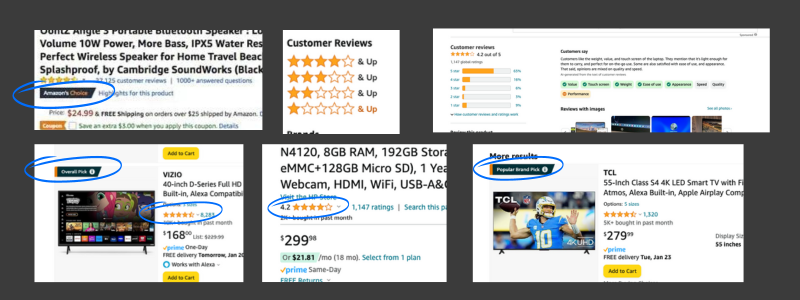
 Authority and Social Proof
Authority and Social Proof
There's a lot going on in that image, but I promise we're going to break it all down.
For this section I'm going over Authority and Social Proof, and I'm sure you likely know a bit about each of them already, but I'm going to expand on how Amazon leverages them in their marketing strategy.
Let's start with Authority.
Authority is another one of Cialdini's 7 Principles of Influence, and extremely important.
So generally I talk about how we can BUILD our own authority, but for this I'm breaking down how Amazon leverages their authority to make you buy more.



As I said, most of the time I'm actually discussing ways you can BUILD your authority.
If you're looking to build your own authority, here are two great resources to read:
- How Alex Hormozi Borrows Authority To Build His Own (Case Study Article)
- How Top LinkedIn Creators Borrow Authority to Build Their Own (LinkedIn Carousel)
Next up is Social Proof.
You're probably getting sick of hearing it; but we've reached another of Cialdini's 7 Principles of Influence.
This is the fourth (and last, I promise) of the principles we'll be breaking down for Amazon.



Justin Welsh is an absolute king of social proof among creators and solopreneurs and uses a loop of overdelivery (which I mentioned above when discussing reciprocity) to continue bringing in more social proof.
A bonus nudge here would also be Herd Mentality.
Herd Mentality refers to the phenomenon where individuals are influenced by the actions, behaviors, or preferences of a larger group.
Amazon uses this by allowing us to see the reviews that have far more 5* or by telling us how many people preferred/like a specific product.
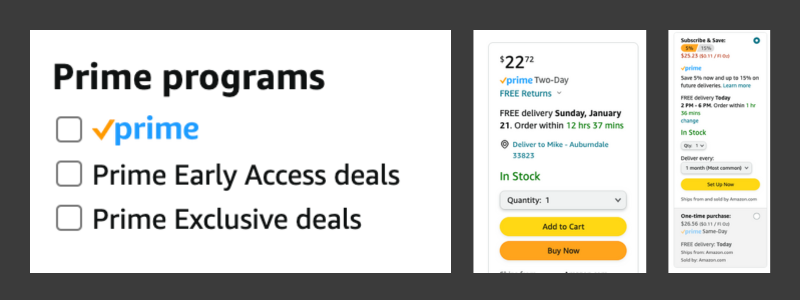
 Exclusivity, Default and Cognitive Fluency
Exclusivity, Default and Cognitive Fluency
Next up we have Exclusivity, Default and Cognitive Fluency.
Since Default and Cognitive Fluency will have some overlap, I'll start with Exclusivity.


When it comes to Default and Cognitive Fluency it may seem a bit obvious, but knowing the psychological bias, and how/why it effects your audience is key.



On the topic of making it simple for our customers, we can move right into Cognitive Fluency.
Behavioral economist and Nobel Prize winner Daniel Kahneman says: “Human Beings are to independent thinking as cats are to swimming. They can do it, but they prefer not to.”
The easier we can make it for our audience, the better.


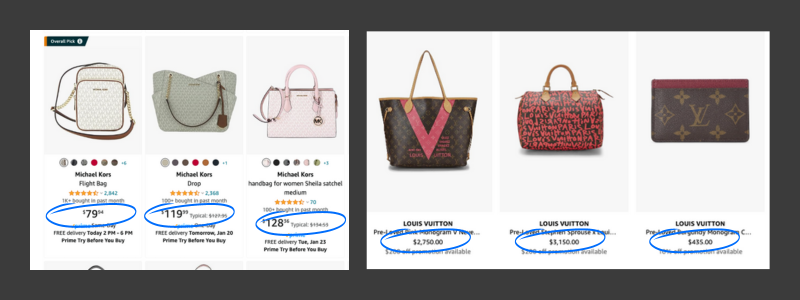
 Charm Pricing and Odd Even Pricing
Charm Pricing and Odd Even Pricing
These are really just two small bonus nudges for you that you can find all over the place, but important to note for Amazon making use of them.
Especially because they're easy for YOU to use as well.
Let's start with what they are, and I can give a couple easy examples to wrap us up:

This one is fairly easy to understand, and something you see on virtually every one of Amazon's pages - hence the need to at least make a quick mention to it.

For example, pricing an item at $19.99 instead of a rounded $20.00.
You may see a "value" bag priced at $29.99, while a Louis Vuitton might be $2200.
If you want to learn about 5 psychological pricing strategies you can check more of them out in another of my LinkedIn carousels.
 Final Notes TL;DR
Final Notes TL;DR
You shouldn't get overwhelmed by this.
If anything it should excite you.
A lot of these are things you can very easily implement into your strategy, and many of them are things you don't need to at all.
TLD;DR - To recap, here are some of the nudges we discussed:
- Default
- Urgency
- Scarcity
- Authority
- Exclusivity
- Social Proof
- Reciprocity
- Loss Aversion
- Charm Pricing
- Herd Mentality
- Price Anchoring
- Odd Even Pricing
- Cognitive Fluency
- Price Perception / Priming
- Foot In The Door Technique
So maybe a few extra bonuses to top off the 13 we set out to discuss.
If you like learning about Science Based Marketing and want to be done with random, ineffective marketing, you can read through more Case Studies, subscribe to the free 2X weekly newsletter or even follow me on LinkedIn.

